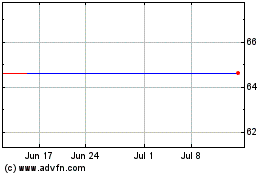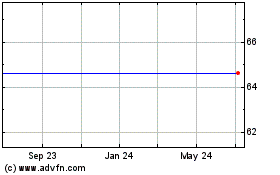Canadian Crude Supply Growth Highlights Need for New Pipeline Capacity, IHS Markit Report Says
April 18 2017 - 10:00AM
Business Wire
Despite renewed optimism for pipeline projects, a history of
delays in the review process raises the possibility of additional
price volatility and loss of economic value for Western Canadian
producers
Western Canada may see a supply increase of nearly a million
barrels of crude by 2020, putting increasing pressure on an already
constrained pipeline system that has struggled with delay in
bringing incremental pipeline capacity online, says a new report by
IHS Markit (Nasdaq: INFO), a world leader in critical information,
analytics and solutions.
Entitled Pipelines, Prices and Promises: The Story of Western
Canadian Market Access, the Canadian Oils Sands Dialogue report
from IHS Markit examines the relationship between pipelines and
prices, the implication of delay in new pipeline capacity that has
occurred in western Canada and the current outlook for the
industry.
Absent new pipeline takeaway capacity, Canadian crudes will face
limitations from the existing pipeline infrastructure as Western
Canadian volumes continue to build, the report says.
“The need for new pipelines departing Western Canada has not
diminished with lower oil prices, quite the opposite,” said Kevin
Birn, energy director for IHS Markit, who leads the Oil Sands
Dialogue. “Canada remains a growth story with production volumes
increasing since the oil price collapse. And with continued growth
it appears inevitable that volumes will overtake an
already-constrained system and create a resurgence of
crude-by-rail.”
The report notes that transportation costs are a key reason why
oil prices differ between regions. While quality differences—such
as light versus heavy oil—result in price differences between
different types of crude oils, transportation costs contribute to
price differences between regions for crude of the same
quality.
Capacity constraints in the past have contributed to price
volatility, a rise of crude-by-rail shipments and a loss of
economic value for Western Canadian producers, the report says.
During one such period of constraint—a five- month period starting
November 2012 through March 2013—Western Canadian Select crude
realized approximately $30/bbl less than Mexican Maya, a crude of
similar quality. The difference in price equaled approximately $6
billion in lost revenue over that period.
A survey of recent major pipeline proposals conducted for the
report found that the length of the pipeline review process (from
first application through the end of 2016) has averaged more than
five years per project, creating uncertainty for project proponents
and western Canadian producers alike.
Although the recent approvals of Keystone XL by the Trump
Administration and Trans Mountain Expansion by the Government of
Canada have returned a level of optimism for pipeline projects,
potential for additional delays exists, the report says.
If four major pipeline projects (Alberta Clipper Expansion,
Energy East, Keystone XL and Trans Mountain Expansion) advance as
currently proposed, they could add 2.9 million barrels per day of
new capacity between 2019 and 2022, enough to move Western Canadian
pipeline takeaway capacity from shortage to surplus.
The report notes that, although the United States (the Gulf
Coast in particular) remains the most likely market for growing
Canadian heavy production due to the regions pre-existing refinery
capacity capable of processing heavier crudes, lessons from the
timing of Keystone XL and concerns over a possible resurgence of
U.S. protectionism have highlighted the importance of market
diversification.
As none of the currently proposed pipeline would come online
prior to 2019, a resurgence of crude-by-rail shipments out of
Western Canada is likely to occur through the end of the decade,
the report concludes.
“Greater price discounts for Western Canadian crudes would
return with an increase of crude-by-rail shipping,” Birn said.
“Such discounts are likely to be more modest than in previous years
as past investments in crude-by-rail infrastructure—such as loading
terminals and railcars—would pay off. But the fact remains that you
will still see increased price volatility and loss of value for
producers until adequate pipeline capacity is restored.”
Pipelines, Prices and Promises: The Story of Western Canadian
Market Access and all other Oil Sands Dialogue research by IHS
Markit is available at www.ihs.com/oilsandsdialogue.
About IHS Markit
(www.ihsmarkit.com)
IHS Markit (Nasdaq: INFO) is a world leader in critical
information, analytics and solutions for the major industries and
markets that drive economies worldwide. The company delivers
next-generation information, analytics and solutions to customers
in business, finance and government, improving their operational
efficiency and providing deep insights that lead to well-informed,
confident decisions. IHS Markit has more than 50,000 key business
and government customers, including 85 percent of the Fortune
Global 500 and the world’s leading financial
institutions. Headquartered in London, IHS Markit is committed
to sustainable, profitable growth.
IHS Markit is a registered trademark of IHS Markit Ltd. All
other company and product names may be trademarks of their
respective owners © 2017 IHS Markit Ltd. All rights reserved.
View source
version on businesswire.com: http://www.businesswire.com/news/home/20170418005231/en/
IHS MarkitJeff Marn,
+1-202-463-8213jeff.marn@ihsmarkit.comorPress Team, +1
303-305-8021press@ihs.comFollow @IHS_News
IHS Markit Ltd. (NASDAQ:INFO)
Historical Stock Chart
From Mar 2024 to Apr 2024

IHS Markit Ltd. (NASDAQ:INFO)
Historical Stock Chart
From Apr 2023 to Apr 2024
